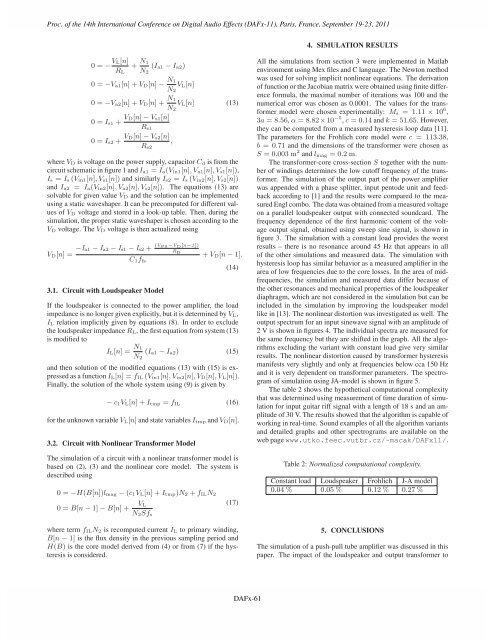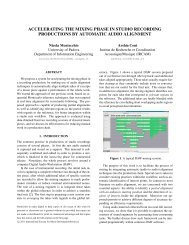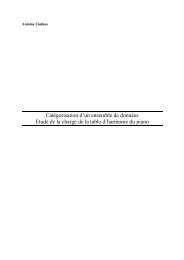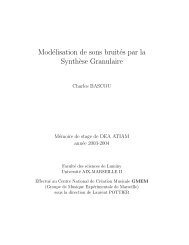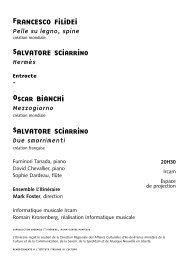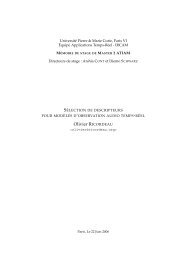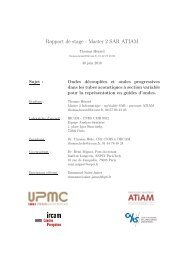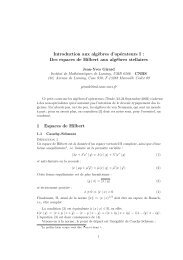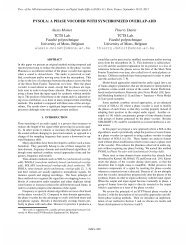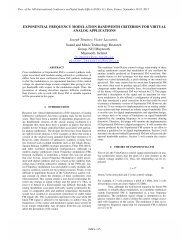Simulation of a Vacuum-Tube Push-Pull Guitar Power Amplifier
Simulation of a Vacuum-Tube Push-Pull Guitar Power Amplifier
Simulation of a Vacuum-Tube Push-Pull Guitar Power Amplifier
You also want an ePaper? Increase the reach of your titles
YUMPU automatically turns print PDFs into web optimized ePapers that Google loves.
Proc. <strong>of</strong> the 14 th Int. Conference on Digital Audio Effects (DAFx-11), Paris, France, September 19-23, 2011Proc. <strong>of</strong> the 14th International Conference on Digital Audio Effects (DAFx-11), Paris, France, September 19-23, 20114. SIMULATION RESULTS0=− VL[n] + N1(I a1 − I a2)R L N 20=−V a1[n]+V D[n] − N1V L[n]N 20=−V a2[n]+V D[n]+ N1V L[n]N 2VD[n] − Vs1[n]0=I s1 +0=I s2 +R s1VD[n] − Vs2[n]R s2,(13)where V D is voltage on the power supply, capacitor C d is from thecircuit schematic in figure 1 and I a1 = I a(V in1[n],V a1[n],V s1[n]),I s = I s (V in1[n],V s1[n]) and similarly I s2 = I s (V in2[n],V s2[n])and I a2 = I a(V in2[n],V a2[n],V s2[n]). The equations (13) aresolvable for given value V D and the solution can be implementedusing a static waveshaper. It can be precomputed for different values<strong>of</strong> V D voltage and stored in a look-up table. Then, during thesimulation, the proper static waveshaper is chosen according to theV D voltage. The V D voltage is then actualized usingV D[n] = −Ia1 − Ia2 − Is1 − Is2 + (V PS−V D [n−1 ])R D+ V D[n − 1].C 1f fs(14)3.1. Circuit with Loudspeaker ModelIf the loudspeaker is connected to the power amplifier, the loadimpedance is no longer given explicitly, but it is determined by V L,I L relation implicitly given by equations (8). In order to excludethe loudspeaker impedance R L, the first equation from system (13)is modified toI L[n] = N1(I a1 − I a2) (15)N 2and then solution <strong>of</strong> the modified equations (13) with (15) is expressedas a function I L[n] =f IL (V in1[n],V in2[n],V D[n],V L[n]).Finally, the solution <strong>of</strong> the whole system using (9) is given by− c 1V L[n]+I tmp = f IL (16)for the unknown variable V L[n] and state variables I tmp and V D[n].3.2. Circuit with Nonlinear Transformer ModelThe simulation <strong>of</strong> a circuit with a nonlinear transformer model isbased on (2), (3) and the nonlinear core model. The system isdescribed using0=−H(B[n])l mag − (c 1V L[n]+I tmp)N 2 + f ILN 20=B[n − 1] − B[n]+VL(17)N 2Sf swhere term f ILN 2 is recomputed current I L to primary winding,B[n − 1] is the flux density in the previous sampling period andH(B) is the core model derived from (4) or from (7) if the hysteresisis considered.All the simulations from section 3 were implemented in Matlabenvironment using Mex files and C language. The Newton methodwas used for solving implicit nonlinear equations. The derivation<strong>of</strong> function or the Jacobian matrix were obtained using finite differenceformula, the maximal number <strong>of</strong> iterations was 100 and thenumerical error was chosen as 0.0001. The values for the transformermodel were chosen experimentally: M s = 1.11 × 10 6 ,3a =8.56, α =8.82×10 −5 , c =0.14 and k =51.65. However,they can be computed from a measured hysteresis loop data [11].The parameters for the Frohlich core model were c = 113.38,b =0.71 and the dimensions <strong>of</strong> the transformer were chosen asS =0.003 m 2 and l mag =0.2 m.The transformer-core cross-section S together with the number<strong>of</strong> windings determines the low cut<strong>of</strong>f frequency <strong>of</strong> the transformer.The simulation <strong>of</strong> the output part <strong>of</strong> the power amplifierwas appended with a phase splitter, input pentode unit and feedbackaccording to [1] and the results were compared to the measuredEngl combo. The data was obtained from a measured voltageon a parallel loudspeaker output with connected soundcard. Thefrequency dependence <strong>of</strong> the first harmonic content <strong>of</strong> the voltageoutput signal, obtained using sweep sine signal, is shown infigure 3. The simulation with a constant load provides the worstresults – there is no resonance around 45 Hz that appears in all<strong>of</strong> the other simulations and measured data. The simulation withhysteresis loop has similar behavior as a measured amplifier in thearea <strong>of</strong> low frequencies due to the core losses. In the area <strong>of</strong> midfrequencies,the simulation and measured data differ because <strong>of</strong>the other resonances and mechanical properties <strong>of</strong> the loudspeakerdiaphragm, which are not considered in the simulation but can beincluded in the simulation by improving the loudspeaker modellike in [13]. The nonlinear distortion was investigated as well. Theoutput spectrum for an input sinewave signal with an amplitude <strong>of</strong>2 V is shown in figures 4. The individual spectra are measured forthe same frequency but they are shifted in the graph. All the algorithmsexcluding the variant with constant load give very similarresults. The nonlinear distortion caused by transformer hysteresismanifests very slightly and only at frequencies below cca 150 Hzand it is very dependent on transformer parameters. The spectrogram<strong>of</strong> simulation using JA-model is shown in figure 5.The table 2 shows the hypothetical computational complexitythat was determined using measurement <strong>of</strong> time duration <strong>of</strong> simulationfor input guitar riff signal with a length <strong>of</strong> 18 s and an amplitude<strong>of</strong> 30 V. The results showed that the algorithm is capable <strong>of</strong>working in real-time. Sound examples <strong>of</strong> all the algorithm variantsand detailed graphs and other spectrograms are available on theweb page www.utko.feec.vutbr.cz/~macak/DAFx11/.Table 2: Normalized computational complexity.Constant load Loudspeaker Frohlich J-A model0.04 % 0.05 % 0.12 % 0.27 %5. CONCLUSIONSThe simulation <strong>of</strong> a push-pull tube amplifier was discussed in thispaper. The impact <strong>of</strong> the loudspeaker and output transformer toDAFX-3DAFx-61


